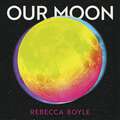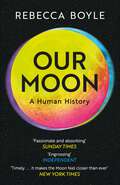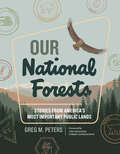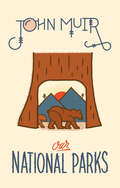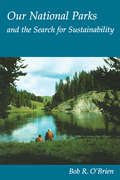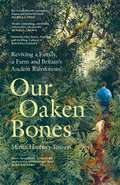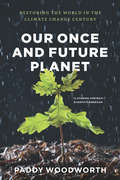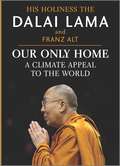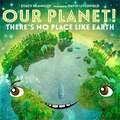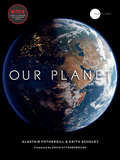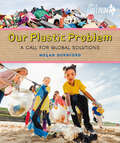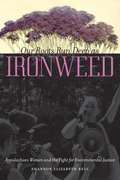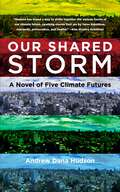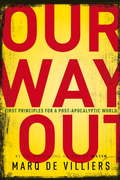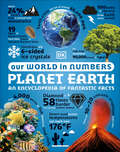- Table View
- List View
Our Moon: A Human History
by Rebecca BoyleA cultural and scientific history of the Moon from prehistoric archaeology to the most recent technological and scientific research today.'A sweeping, lyrical new account of our cosmic neighbour'PETER BRANNEN, author of The Ends of the WorldEvery living being throughout history, across time and geography, has gazed up at the same moon.From the first prehistoric life that crawled onto land guided by the power of the tides, to the division of time into months and seasons for the first humans, the moon has driven the expansion and development of our world.It has inspired scientific discovery and culture from the ancient astronomers to the scientific revolution of Copernicus and Galileo, from the 1969 Apollo landings to writers and artists, and stirred an inexhaustible desire to know where we come from and how we got here.And as astronauts around the world prepare to return to the Moon - opening up new frontiers of discovery, profit and politics - Our Moon tells the dazzling story of how the Moon has shaped life as we know it, fuelled dramatic change across the globe and could be the key to humanity's future.(P)2024 Random House Audio
Our Moon: A Human History
by Rebecca BoyleLonglisted for the National Book Award 2024'Passionate and absorbing'SUNDAY TIMES'I learned more about the Moon by reading this book than after a lifetime of study'CHRIS HADFIELD, author of An Astronaut's Guide to Life on Earth'Superb: as much a feat of imagination as it is a work of globe-trotting scholarship'TELEGRAPH'Boyle's writing shines, shifting through time and space, science and sentiment; a luminous read'REBECCA WRAGG SYKES, author of Kindred'You will never look at the Moon the same way again . . . fascinating'NEW STATESMAN'A riveting feat of science writing'ED YONG, author of An Immense World'Engrossing'INDEPENDENTEvery living being throughout history, across time and geography, has gazed up at the same moon.From the first prehistoric life that crawled onto land guided by the power of the tides, to the division of time into months and seasons for the first humans, the moon has driven the expansion and development of our world.It has inspired scientific discovery and culture from the ancient astronomers to the scientific revolution of Copernicus and Galileo, from the 1969 Apollo landings to writers and artists, and stirred an inexhaustible desire to know where we come from and how we got here.And as astronauts around the world prepare to return to the Moon - opening up new frontiers of discovery, profit and politics - Our Moon tells the dazzling story of how the Moon has shaped life as we know it, fuelled dramatic change across the globe and could be the key to humanity's future.
Our National Forests: Stories from America's Most Important Public Lands
by Greg M. PetersStories from America&’s Most Important Public Lands Across 193 million acres of forests, mountains, deserts, watersheds, and grasslands, national forests provide a multitude of uses as diverse as America itself. Welcoming 170 million visitors each year to hike, bike, paddle, ski, fish, and hunt, &“the people&’s lands&” offer more than just recreation. Timber is harvested, lost habitats are recovered, and endangered wildlife is protected as part of the Forest Service&’s enduring mission. In Our National Forests, Greg Peters reveals an inside look at America&’s most important public land and the people committed to protecting it and ensuring access for all. From the story of how the Forest Service grows millions of seedlings in the West each year, to their efforts to save the hellbender salamander in Appalachia, the narrative spans the breadth of the country and its diverse ecology. People are at the center of the stories, whether the dedicated folks in the Forest Service, or the everyday citizens who support and tend to the protected lands near their homes. This complete look at America&’s National Forests—their triumphs, challenges, controversies, and vital programs—is a must-read for everyone interested in the history of America's most important public lands.
Our National Parks
by John MuirFor every person who has experienced the beauty of the mountains and felt humbled by comparison.John Muir’s Our National Parks—reissued to encourage, and inspire travelers, campers, and contemporary naturalists—is as profound for readers today as it was in 1901.Take in John Muir’s detailed observations of the sights, scents, sounds, and textures of Yosemite, Yellowstone, and forest reservations of the West. Be reminded (as Muir sagely puts), “Wildness is a necessity; and that mountain parks and reservations are useful not only as fountains of timber and irrigating rivers, but as fountains of life.”John Muir’s warmth, humor, and passionate advocacy for these public lands is enough to spur any reader on to plan a National Parks adventure of their own.
Our National Parks and the Search for Sustainability
by Bob R. O'BrienYosemite Valley in July of 1967 would have had to be seen to be believed. There was never an empty campsite in the valley; you had to create a space for yourself in a sea of cars, tents, and humanity. . . . The camp next to ours had fifty people in it, with rugs hung between the trees, incense burning, and a stereo set going full volume. Scenes such as this will probably never be repeated in Yosemite or any other national park, yet the urgent problem remains of balancing the public’s desire to visit the parks with the parks’ need to be protected from too many people and cars and too much development. In this book, longtime park visitor and professional geographer Bob O’Brien explores the National Park Service’s attempt to achieve "sustainability"—a balance that allows as many people as possible to visit a park that is kept in as natural a state as possible. O’Brien details methods the NPS has used to walk the line between those who would preserve vast tracts of land for "no use" and those who would tap the Yellowstone geysers to generate electricity. His case studies of six western "crown jewel" parks show how rangers and other NPS employees are coping with issues that impact these cherished public landscapes, including visitation, development, and recreational use.
Our National Parks and the Search for Sustainability
by Bob R. O'BrienA study of the US National Park Service&’s efforts to allow for as many visitors as possible in the parks that are kept in as natural a state as possible.&“Yosemite Valley in July of 1967 would have had to be seen to be believed. There was never an empty campsite in the valley; you had to create a space for yourself in a sea of cars, tents, and humanity. . . . The camp next to ours had fifty people in it, with rugs hung between the trees, incense burning, and a stereo set going full volume.&”Scenes such as this will probably never be repeated in Yosemite or any other national park, yet the urgent problem remains of balancing the public's desire to visit the parks with the parks&’ need to be protected from too many people and cars and too much development. In this book, longtime park visitor and professional geographer Bob O&’Brien explores the National Park Service&’s attempt to achieve &“sustainability,&” a balance that allows as many people as possible to visit a park that is kept in as natural a state as possible.O&’Brien details methods the NPS has used to walk the line between those who would preserve vast tracts of land for &“no use&” and those who would tap the Yellowstone geysers to generate electricity. His case studies of six western &“crown jewel&” parks show how rangers and other NPS employees are coping with issues that impact these cherished public landscapes, including visitation, development, and recreational use.
Our Oaken Bones: Reviving a Family, a Farm and Britain’s Ancient Rainforests
by Merlin Hanbury-TenisonAn enormously moving and inspiring story about war, trauma, nature and rebirth, written with infectious passion and unsparing honesty. I loved it. - DOMINIC SANDBROOKScholarly, wise, funny, charming, terrifying and thrilling... I adored it all, every page. - JOANNA LUMLEYThis is a lovely book - wise, brave, thoughtful, painfully intimate - but with a remarkable spiritual and environmental vision. - RORY STEWARTAn extraordinarily courageous, urgent and powerful book. - ISABELLA TREEDeeply compelling... emotional, informative, pleasurable. I believe that this is an important work with planet-sized dreams and ambitions. Perhaps the greatest philosophy or teachable lesson that came to me off the page is that dominion comes with responsibility. - RUSSELL CROWEI love this book. - RICK STEINPowerfully enchanting, written with verve and imbued with hope. - GUY SHRUBSOLEI lie on the rock to let my limbs dry after my immersion in the river. My bones warm. I have no towel but the moss is grateful for the additional moisture that I bring as the water runs off me and into its spongy web of roots and branches. I look up through the canopy and time freezes as the oak leaves drift gently backwards and forwards, dappling the light as it falls onto my body.I am home.Reeling from the pain of devastating miscarriages and suffering from PTSD after military adventures in Afghanistan, Merlin and his wife Lizzie decide to leave the bustle of London and return to Merlin’s childhood home, a Cornish hill farm called Cabilla in the heart of Bodmin Moor.There, they are met by unexpected challenges: a farm slipping ever further into debt, the discovery that the overgrazed and damaged woods running throughout the valley are in fact one of the UK’s last remaining fragments of Atlantic temperate rainforest, and the sudden and near catastrophic strickening by Covid of Merlin’s father, the explorer Robin. As they fall more in love with the rainforest that Merlin had adventured in as a child, so begins a fight to save not only themselves and their farm, but also one of the world’s most endangered habitats.Our Oaken Bones is an honest and intimate true story about renewal, the astonishing healing power of nature, and our duty to heal it in return.For fans of The Salt Path and The Lost Rainforests of Britain.
Our Once and Future Planet: Restoring the World in the Climate Change Century
by Paddy WoodworthThe environmental movement is plagued by pessimism. And that’s not unreasonable: with so many complicated, seemingly intractable problems facing the planet, coupled with a need to convince people of the dangers we face, it’s hard not to focus on the negative But that paints an unbalanced—and overly disheartening—picture of what’s going on with environmental stewardship today. There are success stories, and Our Once and Future Planet delivers a fascinating account of one of the most impressive areas of current environmental experimentation and innovation: ecological restoration. Veteran investigative reporter Paddy Woodworth has spent years traveling the globe and talking with people—scientists, politicians, and ordinary citizens—who are working on the front lines of the battle against environmental degradation. At sites ranging from Mexico to New Zealand and Chicago to Cape Town, Woodworth shows us the striking successes (and a few humbling failures) of groups that are attempting to use cutting-edge science to restore blighted, polluted, and otherwise troubled landscapes to states of ecological health—and, in some of the most controversial cases, to particular moments in historical time, before widespread human intervention. His firsthand field reports and interviews with participants reveal the promise, power, and limitations of restoration. Ecological restoration alone won’t solve the myriad problems facing our environment. But Our Once and Future Planet demonstrates the role it can play, and the hope, inspiration, and new knowledge that can come from saving even one small patch of earth.
Our Once and Future Planet: Restoring the World in the Climate Change Century
by Paddy WoodworthThe environmental movement is plagued by pessimism. And that’s not unreasonable: with so many complicated, seemingly intractable problems facing the planet, coupled with a need to convince people of the dangers we face, it’s hard not to focus on the negative But that paints an unbalanced—and overly disheartening—picture of what’s going on with environmental stewardship today. There are success stories, and Our Once and Future Planet delivers a fascinating account of one of the most impressive areas of current environmental experimentation and innovation: ecological restoration. Veteran investigative reporter Paddy Woodworth has spent years traveling the globe and talking with people—scientists, politicians, and ordinary citizens—who are working on the front lines of the battle against environmental degradation. At sites ranging from Mexico to New Zealand and Chicago to Cape Town, Woodworth shows us the striking successes (and a few humbling failures) of groups that are attempting to use cutting-edge science to restore blighted, polluted, and otherwise troubled landscapes to states of ecological health—and, in some of the most controversial cases, to particular moments in historical time, before widespread human intervention. His firsthand field reports and interviews with participants reveal the promise, power, and limitations of restoration. Ecological restoration alone won’t solve the myriad problems facing our environment. But Our Once and Future Planet demonstrates the role it can play, and the hope, inspiration, and new knowledge that can come from saving even one small patch of earth.
Our Only Home: A Climate Appeal to the World
by Dalai Lama Franz AltSaving the climate is our common duty. With each passing day, climate change is causing Pacific islands to disappear into the sea, accelerating the extinction of species at alarming proportions and aggravating a water shortage that has affected the entire world. In short, climate change can no longer be denied—it threatens our existence on earth.In this new book, the Dalai Lama, one of the most influential figures of our time, calls on political decision makers to finally fight against deadlock and ignorance on this issue and to stand up for a different, more climate-friendly world and for the younger generation to assert their right to regain their future.From the voice of the beloved world religious leader comes an eye-opening manifesto that empowers the generation of today to step up, take action and save our environment.
Our Planet! There's No Place Like Earth (Our Universe #6)
by Stacy McAnultyFrom writer Stacy McAnulty and illustrator David Litchfield, Our Planet! There's No Place Like Earth is a nonfiction picture book about the Earth, told from the perspective of Earth herself.Meet Earth. Planet Awesome! And your awesome home! Actually, Earth is home to all the plants and all the animals in the solar system, including nearly eight billion people. Humans have accidentally moved Earth's climate change into the fast lane, and she need your help to put on the brakes. Earthlings need Earth, and Earth needs Earthlings, so let’s save Earth together!With characteristic humor and charm, Stacy McAnulty channels the voice of Earth in this next celestial "autobiography" in the Our Universe series. Rich with kid-friendly facts and beautifully brought to life by David Litchfield, this is an equally charming and irresistible picture book.
Our Planet: And Our Planet's Surprising Future
by Fred Pearce Alastair Fothergill Keith ScholeyWith a foreword by Sir David Attenborough, this is the striking photographic companion to the groundbreaking NETFLIX original documentary series, presenting never-before-seen visuals of nature's most intriguing animals in action and the environmental change that has to be seen to be believed.With six hundred members of crew filming in fifty countries over four years, the directors that brought us the original Planet Earth and Blue Planet now take readers on a journey across all the globe’s different biological realms to present stunning visuals of nature's most intriguing animals in action, and environmental change on a scale that must be seen to be believed. Featuring some of the world's rarest creatures and previously unseen parts of the Earth―from deep oceans to remote forests to ice caps―Our Planet takes nature-lovers deep into the science of our natural world. Revealing the most amazing sights on Earth in unprecedented ways, alongside stories of the ways humans are affecting the world’s ecosystems―from the wildebeest migrations in Africa to the penguin colonies of Antarctica―this book places itself at the forefront of a global conversation as we work together to protect and preserve our planet. With a keepsake package featuring debossing and foil stamping, this groundbreaking coffee-table book reveals the most amazing sights on Earth in unprecedented ways.
Our Plastic Problem: A Call for Global Solutions (Orca Footprints #33)
by Megan DurnfordWe have a serious plastic problem. What was supposed to be a miracle material when it was first invented is now one of the biggest sources of pollution on our planet. But where does plastic come from? Why do we use so much of it? How does it hurt the environment and the animals who live there? Our Plastic Problem looks at plastic's history, uses, and how it affects land, water, air and human health. It also explores innovations in bioplastic and recycling, and practical ways to reduce and replace the plastic in our lives. Working together, we can solve our plastic problem.
Our Roots Run Deep as Ironweed: Appalachian Women and the Fight for Environmental Justice
by Shannon Elizabeth BellMotivated by a deeply rooted sense of place and community, Appalachian women have long fought against the damaging effects of industrialization. In this collection of interviews, sociologist Shannon Elizabeth Bell presents the voices of twelve Central Appalachian women, environmental justice activists fighting against mountaintop removal mining and its devastating effects on public health, regional ecology, and community well-being. Each woman narrates her own personal story of injustice and tells how that experience led her to activism. The interviews--many of them illustrated by the women's "photostories"--describe obstacles, losses, and tragedies. But they also tell of new communities and personal transformations catalyzed through activism. Bell supplements each narrative with careful notes that aid the reader while amplifying the power and flow of the activists' stories. Bell's analysis outlines the relationship between Appalachian women's activism and the gendered responsibilities they feel within their families and communities. Ultimately, Bell argues that these women draw upon a broader "protector identity" that both encompasses and extends the identity of motherhood that has often been associated with grassroots women's activism. As protectors, the women challenge dominant Appalachian gender expectations and guard not only their families but also their homeplaces, their communities, their heritage, and the endangered mountains that surround them. 30% of the proceeds from the sale of this book will be donated to organizations fighting for environmental justice in Central Appalachia.
Our Shared Storm: A Novel of Five Climate Futures
by Andrew Dana HudsonThrough speculative fiction, five interlocking novelettes explore the possible realities of our climate future.What is the future of our climate? Given that our summers now regularly feature Arctic heat waves and wildfire blood skies, polar vortex winters that reach all the way down to Texas, and “100-year” storms that hit every few months, it may seem that catastrophe is a done deal. As grim as things are, however, we still have options. Combining fiction and nonfiction and employing speculative tools for scholarly purposes, Our Shared Storm explores not just one potential climate future but five possible outcomes dependent upon our actions today. Written by speculative-fiction writer and sustainability researcher Andrew Dana Hudson, Our Shared Storm features five overlapping fictions to employ a futurist technique called “scenarios thinking.” Rather than try to predict how history will unfold—picking one out of many unpredictable and contingent branching paths—it instead creates a set of futures that represent major trends or counterposed possibilities, based on a set of climate-modeling scenarios known as the Shared Socioeconomic Pathways (SSPs).The setting is the year 2054, during the Conference of the Parties global climate negotiations (a.k.a., The COP) in Buenos Aires, Argentina. Each story features a common cast of characters, but with events unfolding differently for them—and human society—in each alternate universe. These five scenarios highlight the political, economic, and cultural possibilities of futures where investments in climate adaptation and mitigation promised today have been successfully completed, kicked down the road, or abandoned altogether. From harrowing to hopeful, these stories highlight the choices we must make to stabilize the planet.Our Shared Storm is an experiment in deploying practice-based research methods to explore the opportunities and challenges of using climate fiction to engage scientific and academic frameworks.
Our Uncommon Heritage
by Charles PerringsBiodiversity change is the biggest environmental problem of our time. It leads to much more than species extinctions, affecting the food we eat, the diseases we face, our vulnerability to fire and flood, and our ability to adapt to climate change. Our Uncommon Heritage explores the many dimensions of human-driven biodiversity change. It integrates ecology, economics and policy to examine the causes and consequences of changes in ecosystems, species and genes, and to identify better ways to manage those changes. It explores the place of biodiversity in the wealth of nations, the rights and responsibilities people have for natural resources at local, regional, national and international levels, and the challenges faced in protecting the common good at the global level. This is an important book for students and researchers in the fields of conservation and sustainability science, ecology, natural resource economics and management. It also has much to say to those engaged in international conservation, health, agriculture, forestry and fisheries policy.
Our Way Out: Principles for a Post-apocalyptic World
by Marq De VilliersGlobal warming, energy shortages, overpopulation -- it's no wonder that as a society, we're in an apocalyptic mood. Out of an endless stream of gloomy prognoses for humanity's future, we have emerged with little inspiration and few concrete ideas for change. Our Way Out is the first time that our most urgent global challenges have been treated as aspects of a single, larger crisis -- and the first to acknowledge that while crises reinforce each other, solutions enable each other. The transformation to sustainability is already happening, in many small ways, in many parts of the world. Our Way Out shows us how we can scale up these efforts to create meaningful and lasting change.This is not a book on climate change, energy, or any other single issue -- it is the story of how within the solutions to the global crises we face, lie the seeds of something greater. It is a handbook for immense and exciting worldwide change. And, not least of all, it offers us robust hope that we can make things better.From the Hardcover edition.
Our Wondrous World - The World Around Us class 3 - NCERT-25
by National Council of Educational Research and TrainingOur Wondrous World is an integrated, interdisciplinary textbook developed by NCERT for Class 3 students, aligning with the National Education Policy (NEP) 2020 and the National Curriculum Framework for School Education (NCF-SE) 2023. Designed for the subject "The World Around Us," the book fosters experiential, inquiry-based learning by connecting students' daily experiences with foundational concepts from science, social science, and environmental education. Divided into four thematic units—families and communities, life around us, gifts of nature, and our environment—the book encourages curiosity, critical thinking, and active engagement through storytelling, activities, illustrations, and open-ended questions. It also promotes values like empathy, inclusion, environmental sensitivity, and cultural awareness, nurturing holistic development and preparing children for the Middle Stage of schooling.
Our World (Environmental Studies) Semester - 1 class 3 - Andhra Pradesh Board
by State Council of Educational Research and Training Andhra PradeshThe Class 3 Andhra Board EVS Semester 1 Textbook, titled Our World, is designed to foster environmental awareness and holistic learning among students. The book incorporates lessons on themes such as family, plants, animals, our body, food, water, and fundamental duties, encouraging practical engagement and conceptual understanding. Each lesson begins with relatable scenarios, followed by activities like hands-on experiments, discussions, and projects to strengthen comprehension. Colorful illustrations and QR codes support interactive learning. Key concepts include the significance of sharing responsibilities within families, the role of plants and animals in our ecosystem, personal hygiene, and healthy food habits. It emphasizes environmental conservation, the importance of water, and ethical behavior through stories and activities. The curriculum aligns with global educational standards and incorporates Continuous and Comprehensive Evaluation (CCE) techniques, focusing on building foundational skills, critical thinking, and creativity. Overall, the textbook promotes scientific temperament and moral values, inspiring students to care for their surroundings and contribute to societal harmony.
Our World (Environmental Studies) Semester - 1 class 4 - Andhra Pradesh Board
by State Council of Educational Research and Training Andhra PradeshThe textbook Our World: Environmental Studies, Semester 1 for Class 4 is an engaging resource developed by Samagra Shiksha under the Government of Andhra Pradesh. Designed to instill environmental awareness in young learners, the book emphasizes hands-on learning and exploration. Covering themes like family, plants and animals, food and water, communication, traditions, and the universe, it contains eleven chapters enriched with colorful illustrations and real-life scenarios to enhance understanding. Activities such as experiments, projects, and discussions encourage active participation and critical thinking. The textbook also integrates key values like environmental conservation, kindness, and community living. With a focus on contextual learning aligned with NCERT outcomes, it promotes conceptual clarity and nurtures skills like questioning, observation, and appreciation of diversity in surroundings.
Our World (Environmental Studies) Semester - 2 class 3 - Andhra Pradesh Board
by State Council of Educational Research and Training Andhra PradeshThe Class 3 Andhra Board EVS Semester 2 Textbook, titled Our World, published by the Government of Andhra Pradesh, focuses on foundational environmental studies tailored for young learners. The textbook features eleven lessons exploring themes such as shelters, transport, communication, recreation, and directionality, emphasizing conceptual understanding, hands-on activities, and real-life connections. It incorporates vibrant illustrations, bilingual content, and QR codes for enhanced learning experiences. Lessons include topics like evolution and diversity of shelters, roadways and traffic systems, modes of communication, and indoor and outdoor games. Activities such as model-making, discussions, and project work aim to foster creativity, teamwork, and critical thinking. The curriculum aligns with the National Educational Policy guidelines, promoting inclusivity and respect for nature and diverse cultural practices. This resource encourages experiential learning to help children appreciate their environment and develop essential life skills.
Our World (Environmental Studies) Semester - 2 class 4 - Andhra Pradesh Board
by State Council of Educational Research and Training Andhra PradeshThe Class 4 Environmental Studies Semester 2 textbook, titled Our World, designed by the Andhra Pradesh government under Samagra Shiksha, encourages a practical and inclusive approach to learning. With themes like professions, transport, communication, festivals, and geography, the book integrates real-life examples and projects to foster understanding. It features eleven bilingual chapters, blending local relevance with national and global perspectives. Activities and QR codes provide opportunities for exploration, ensuring alignment with NCERT learning outcomes. Vibrant illustrations and hands-on tasks like model-making, discussions, and field observations promote scientific curiosity, creativity, and appreciation for diversity. The book also emphasizes values like teamwork, environmental stewardship, and respect for all professions, aligning with foundational constitutional ideals.
Our World (Environmental Studies) Semester - 2 class 5 - Andhra Pradesh Board
by State Council of Educational Research and Training Andhra PradeshThe Class 5 Environmental Studies Semester 2 textbook, titled "Our World", is designed to foster an understanding and appreciation of the environment among young learners. Published by the Government of Andhra Pradesh under the Samagra Shiksha initiative, the book features a bilingual approach to make learning accessible. It covers themes like family, nature, safety, governance, and the Indian freedom struggle, integrating real-life scenarios and hands-on activities. Each chapter includes colorful illustrations, QR codes for enhanced learning, and a variety of activities to promote critical thinking, creativity, and engagement. The book aligns with global educational standards and emphasizes foundational concepts, scientific temper, and values such as kindness and teamwork. Special features include learning outcomes, key terms, and summaries to reinforce concepts. Designed with inputs from educational experts, the textbook aims to cultivate environmental awareness, civic responsibility, and academic skills in students.
Our World (Environmental Studies) Semester-1 class 5 - Andhra Pradesh Board
by State Council of Educational Research and Training Andhra PradeshThe textbook "Our World: Environmental Studies, Semester 1" for Class 5, developed by Samagra Shiksha under the Government of Andhra Pradesh, is an engaging educational resource aimed at fostering environmental awareness among young learners. Structured around themes such as migration, climate change, organ systems, agriculture, water conservation, and cultural traditions, the book comprises eleven thoughtfully crafted chapters. These chapters are enriched with vivid illustrations, real-life examples, and interactive activities to encourage hands-on learning and exploration. By integrating exercises like experiments, projects, and group discussions, the textbook promotes critical thinking and active participation. It also emphasizes essential values like sustainability, empathy, and community welfare, instilling a sense of responsibility towards nature and society. With a curriculum aligned to NCERT learning outcomes, the book nurtures core competencies such as observation, analysis, and conceptual clarity while celebrating cultural diversity and ecological balance. Through its creative and practical approach, the textbook serves as a vital tool in shaping environmentally conscious and socially aware citizens.
Our World in Numbers: Planet Earth (DK Oour World in Numbers)
by DKLearn about everything on planet Earth with this book of extraordinary figures and number-based facts for children aged 9-12!Put the fun back into learning and take children on a number-crunching journey around our incredible planet. From microscopic minerals to majestic mountains and everything in between, learn all about planet Earth with more than 1,000 weird and wonderful numbers.Our World in Numbers: Planet Earth will have you impressing your family and friends like never before with mind-blowing figures behind rising sea levels, the gradual growth of mountains, and wild weathers. Children aged 9-12 will number-crunch their way around the planet, discovering everything about world's biggest oceans, rivers, and mountains.This Earth book of fantastic figures offers:More than 1,000 astonishing Earth facts for children aged 9-12.Different topics divided by 5 chapters that explore the planet.Eye-catching double page features, including vibrant photographs and graphics for every topic.Fun and surprising information on more than 80 topics to engage children in the world around them.This data-packed adventure through the animal world is filled with everything you’ve ever wanted to know about the planet, with full-page photographs and fun, colorful images, wacky fact-bites, and funky figures to become an animal expert! More in the seriesOur World in Numbers explores figures and number-based facts through exciting topics, vibrant photos and exciting graphics. If you liked Our World in Numbers: Planet Earth, why not try Our World in Numbers: Animals, and learn about the animal kingdom, or Our World in Numbers: Dinosaurs, and discover the prehistoric world.
